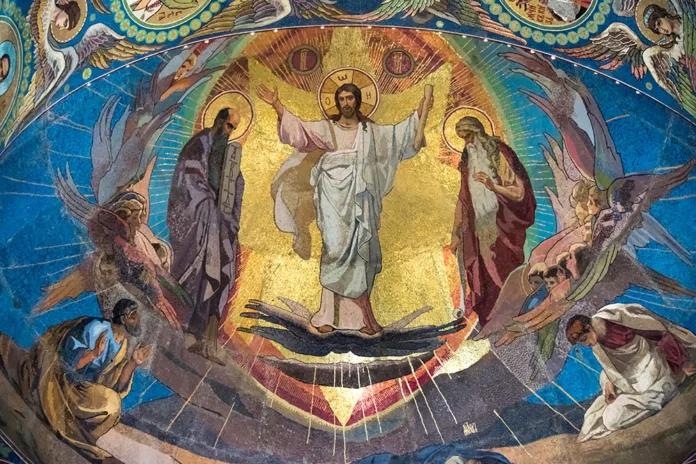After His passion and death on the cross, Jesus’ body is placed in the tomb where He has the true sabbath rest. Jesus intentionally ends His act of new creation that establishes a new covenant on the Sabbath to signal that His work on Earth is complete. However, Jesus had to descend to an even greater depth. His human soul united to His divine person then entered Hell, the abode of the dead, which held all of the righteous and unrighteous souls who had died prior to Jesus. There He preached the Gospel to all of the souls. To the righteous who responded in faith, He took them with Him, diminishing the power of death.
On the morning of the third day, the first day of the week, some of the women who had been Jesus’ crucifixion led by Mary Magdalene went early to the tomb, but found the stone that had covered the tomb rolled away. An angel appears to Mary and tells her that Jesus had been raised from the dead. Jesus then also appears to Mary Magdalene who does not recognize Him at first in His resurrected body. It is only when He calls her by name, that she recognizes Him. The women hasten to tell the Apostles, but the Apostles do not believe until Jesus appears to them Himself. Over the span of the next forty days, Jesus appears to more than five hundred of His disciples, charging them with the task to go out and make disciples of all nations.
Death had been defeated! When Jesus died, He went to the place where all dead people went: Hell. At that time, it was the abode of all the dead, not just the damned. The righteous were held captive there because of their fallen nature. Due to His life on earth, when Jesus descended into Hell the gates of Hell could not keep Him captive because He is without sin. He took with Him all the righteous who accepted His life. In Jesus, they were freed and entered into their eternal reward. This is the good news that the disciples of Jesus now spread to the world. Because of the love of God, new life is given to those who believe in the resurrection of Jesus, Son of God and enter into His life.
While God can do whatever He wants, He works within the bounds of natural law which He created. This means His works are ordered and beautiful. From before the beginning of time, anything or anyone that transgresses God’s law loses full communion with God. Within the bounds of time, anything material that is marred by sin is destined to lose its immortality and die. Adam and Eve, who were given immortality by eating from the Tree of Life in the Garden of Eden, lose access to the Tree because they fell out of trust in God and His divine will. From that moment on, the descendents of Adam and Eve, inherited their original sin and the desire to sin that went with it. Consequently, all of us who are lost in our sin, would not only die a physical death, but a spiritual death of eternal separation from God. This is divine justice; that all who transgress against the Author of Life are eternally separated from Him, and all who obey the Author of Life in love, remain with Him forever.
After the sin of Adam and Eve, God could have left the human race in divine justice and separation from Him, but out of love for His creation, He desired to bring us back to Him.
He taught the Israelites how to live in Him and trust in Him by giving them the Law of Moses. The Israelites fail time and time again, but all sin and the consequences of sin were gathered into one place: under the Law. Then Jesus comes. By living a life of perfect obedience to the Father, He upholds the Law and fulfills it when all others have failed. In being fully human, He fulfills the human side of the New Covenant of complete devotion to the Father. His perfection allows Him to be a perfect, acceptable sacrifice for the curse of the law that was incurred by the transgressions of earlier covenants under the Old Law.
The death of an innocent man, one without sin, cries out more eloquently than that of Abel’s (Hebrews 12:24). While the one who dies in sin deserves his death, divine justice demands that a man who dies without transgressing the divine law of God must not stay dead. This is why Jesus could not stay dead. It is why death had no hold on Him. It is because Satan, who had been prince over the sinful, had to follow God’s divine law and had no power in Jesus’ death. Jesus breaks the chain of sin and death through His perfect life and death of obedience and love of the Father.
In receiving divine justice from God in His resurrection, Jesus now extends to us divine mercy to all who enter into His life. The resurrected life of Jesus is a complete gift to His followers. Nothing we could have done would have earned us this new life. This mercy is so complete, that all of our sins from our past way of life are completely erased from our ledger. God holds no repentant sinner accountable for His sins because when we enter into Jesus’ life, God only sees the beloved love and obedience of His Son, not our disobedience. No matter the greatness or repetition of our sin, it is completely wiped clean. This is how God desires to look on us, His children. He is slow to anger and abounding in mercy (Psalm 145:8).
In receiving the divine justice given to Jesus through the divine mercy that He offers each of us, we are elevated to something greater than Adam and Eve before the fall. At the time, they were adjacent to God in terms of perfection and being able to stand in His presence. However, when we die with Jesus so that we may rise with Him (Romans 6:8), we are elevated into life and inheritance of the Son. No longer are we adjacent, we are in the blessed life of love of the Trinity, and we will remain there for all eternity. That is the power of the resurrection, and that is the life for which we were created.






